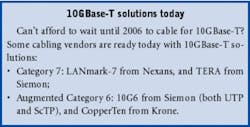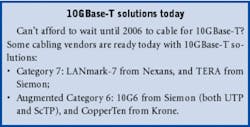If we have learned any lessons at all from Category 6, it is that the Institute of Electrical and Electronics Engineers (IEEE; www.ieee.org) has huge influence on the value that our cabling designs provide to our clients.
Last month, I promised a report on TIA TR-42's progress on their Augmented Category 6 cabling standard. Here it is.
What we know so far
Augmented Cat 6 cabling will support 10GBase-T over a worst-case 100-meter (m), four-connection topology.
Augmented Category 6 cabling will meet the requirements of Draft 1 of TIA Telecommunications Systems Bulletin TSB-155, ANSI/TIA/EIA-568-B.2 Addendum 1 (Category 6), ISO/IEC 11801 Edition 2: 2002 Class E channel and Class F channel insertion loss. Power-sum alien near-end crosstalk will meet:
- PSANEXT ≥60 10log(f), 1≤f≤100 MHz
- PSANEXT ≥60 15log(f), 100
ANSI/TIA/EIA-568B.2 Addendum 1 Category 6 and ISO/IEC 11801 Edition 2: 2002 Class E carefully characterize Category 6 between 1 and 250 MHz; however, no standard has ever been published regarding performance of Category 6/Class E beyond 250 MHz.
And "beyond" is precisely where IEEE 802.3an is looking for the operating range for 10GBase-T. IEEE 802.3an has requested that cabling be characterized between 1 and 625 MHz.
TSB-155 work in progress
TSB-155 is a current work item (PN-3-0134) for TR-42.7.
- It addresses 100-Ω, 4-pair Category 6 cabling that has been installed in accordance with TIA/EIA-568-B.2 Addendum 1, and further characterizes Category 6 cabling from 250 MHz up to 625 MHz.
Translation:It meets IEEE's request of 625 MHz, but only for Category 6. There is no mention of our huge installed base of Category 5e cabling.
- PN-3-0134 provides requirements for Level IIIe (625 MHz) field testers.
Observation:We are going to be buying new field testers to see if our existing cable can deliver the data across a much greater bandwidth than it was designed to support.
- PN-3-0134 also defines alien crosstalk and how to avoid the problem.
Translation:It is up to the designer to specify a cabling system intended to reduce alien near-end crosstalk and design a pathway system that avoids having large bundles of cable running parallel to each other.
TIA/EIA-568B.2 Addendum 10 Augmented Category 6 Cabling is also a work item for TR-42.7. TR-42.7 reports that Draft 1 on Augmented Category 6 cabling should be available after the next TIA TR-42 meeting in October.
Observation:There are unresolved issues within the committee on what changes are necessary in the cable and connector specifications to achieve Augmented Category 6.
TR-42.7 has requested that IEEE 802.3an adopt Augmented Category 6 cabling as a media objective for 10GBase-T.
Something to think about ...
Today, Category 5e and Category 6 support virtually the same IEEE applications, leaving Category 6 sort of a "cable without a cause."
TIA TR-42.7 is busy lobbying IEEE to accept Augmented Category 6 as the media of choice for 10GBase-T.
TSB-155 is addressing a previously uncharacterized bandwidth range for Category 6: 250 MHz to 625 MHz.
Meanwhile, Alan Flatman, principal consultant with LAN Technologies, is presenting data that shows by the time IEEE 802.3an is published, in July 2006, 50% of the "installed base" of cabling will still be Category 5e.
Observation:It appears that we will all be using our new testers to see just how far we can push 10GBase-T on that installed base, since no one is working on a TSB to characterize Category 5e.
The 'power' solution
10-Gigabit Ethernet was originally created for use in campus, metropolitan area networks (MANs), and wide area networks (WANs), but as usual, what starts in the backbone soon finds its way onto the horizontal.
So, why do we need a copper solution? Two words: "power" and "money."
The former I spoke about last month—data terminal equipment (DTE) powering. Copper cabling has the ability to provide Power over Ethernet to network devices. Wireless access points, telephones, and countless other devices on the market can accept low-voltage power supplied by a switch rather than requiring a separate power outlet. Equip the switch with back-up power and your applications are running even when the building power is not.
And then there is the money. End users have it (although not nearly as much as in previous years), and everyone else—equipment manufacturers, cabling-component manufacturers, and designers and installers—want it. If equipment manufacturers can produce a box that will push 10-Gig over the structured cabling systems that end users have already had designed and installed, then there would be more money to spend on new equipment.
Since currently about 0.6% of the installed base of structured cabling is fiber-to-the-desk, selling 10GBase-SR or 10GBase-LX4 boxes would mean installing new fiber cabling. This would take a healthy bite out of the end user's budget. Great for the fiber-cabling component manufacturers, but not a good plan for the equipment manufacturers.
Enter 10GBase-T, the copper solution. According to the project authorization request, IEEE 802.3an is intended to provide a lower-cost, twisted-pair cabling option for 10-Gbit/sec equipment up to 100 meters. (See www.ieee802.org/3/an.)
In IEEE 802.3, the decision to move forward with a project is based on fulfillment of five criteria:
- Broad market potential;
- Compatibility with IEEE Standard 802.3;
- Distinct identity;
- Technical feasibility;
- Economic feasibility.
Total installation cost is one of the considerations for economic feasibility. The study group reported that the cost of 10GBase-T hardware would not exceed the cost of 1000Base-T hardware by more than a factor of three. The study group also stated that the "widespread use and low cost of installation of structured twisted-pair cabling systems" supported the "economic feasibility" with regard to total cost of installation.
Only one cabling system, Class F/Category 7, is currently characterized in a standard and will support 10GBase-T for a 100-meter channel.
Currently, about 0.4% of the installed base of structured cabling is Category 7. Hence, new cabling would have to be installed, which would also take a healthy bite out of the end user's budget. Great for the cabling-component manufacturers, but again, not a good plan for the equipment manufacturers.
But TIA does not recognize Category 7, so they are busy "augmenting" Category 6 and lobbying for acceptance.
The channel-performance specifications for Augmented Category 6, outlined above, are sufficiently stable to where manufacturers are confident that their product will meet the mark.
Standard or no standard, it is unlikely that all Augmented Category 6 components will be interoperable (i.e., work together). Interoperability was not nearly as big an issue at 100 MHz and 250 MHz as it will become at 625 MHz. For example, connect a Category 5e plug from any manufacturer to a Category 5e jack from any other manufacturer, and you get Category 5e performance. Perhaps not as good a performance as you could have gotten if you had used a plug and jack from the same manufacturer, but still Category 5e. With Augmented Category 6, however, if you mix components from one manufacturer with those of another, you very likely will not get Augmented Category 6 performance.
The Augmented Category 6 cabling solutions offered today are proprietary. To construct a channel that meets the proposed Augmented Category 6 performance, either select all cabling components—cable, patch cords, and connecting hardware—from the same Category 6 product series, or test the selected components for interoperability with the channel.
Donna Ballast is BICSI's standards representative, and a BICSI registered communications distribution designer (RCDD). Send your questions to Donna via e-mail: [email protected]


